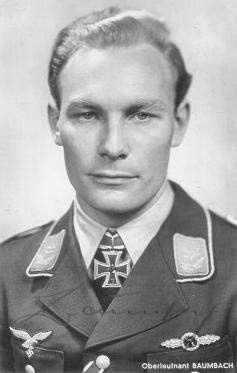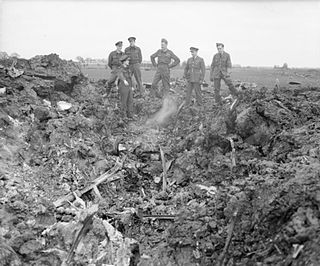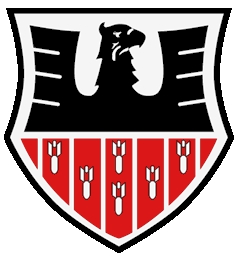
The Junkers Ju 88 is a German World War II Luftwaffe twin-engined multirole combat aircraft. Junkers Aircraft and Motor Works (JFM) designed the plane in the mid-1930s as a so-called Schnellbomber that would be too fast for fighters of its era to intercept. It suffered from technical problems during its development and early operational periods but became one of the most versatile combat aircraft of the war. Like a number of other Luftwaffe bombers, it served as a bomber, dive bomber, night fighter, torpedo bomber, reconnaissance aircraft, heavy fighter and at the end of the war, as a flying bomb.

Mistel was the larger, unmanned component of a composite aircraft configuration developed in Germany during the later stages of World War II. The composite comprised a small piloted control aircraft mounted above a large explosives-carrying drone, the Mistel, and as a whole was referred to as the Huckepack ("Piggyback"), also known as the Beethoven-Gerät or Vati und Sohn.

Werner Baumbach was a German bomber pilot during World War II. He commanded the secret bomber wing Kampfgeschwader 200 of the Luftwaffe, the air force of Nazi Germany. Baumbach received the Knight's Cross of the Iron Cross with Oak Leaves and Swords for the destruction of over 300,000 gross register tons (GRT) of Allied shipping.

Laon-Couvron Air Base is a former French and United States Air Force base in France. It is located in the Aisne département of France, less than one mile southeast of the village of Couvron and 6 miles northwest of Laon; on the southwest side of the Autoroute des Anglais 1 Mile (1.6 km) east of the village of Couvron-et-Aumencourt.

The Leonidas Squadron, formally known as "5th Staffel of Kampfgeschwader 200", was a unit which was originally formed to fly the Fieseler Fi 103R Reichenberg, a manned version of the V-1 flying bomb, in attacks in which the pilot was likely to be killed, or at best to parachute down at the attack site. The Reichenberg was never used in combat because Werner Baumbach, the commander of KG 200, and his superiors considered it an unnecessary waste of life and resources. The Mistel composite aircraft was preferred.

Operation Steinbock or Operation Capricorn, sometimes called the Baby Blitz, was a strategic bombing campaign by the German Air Force during the Second World War. It targeted southern England and lasted from January to May 1944. Steinbock was the last strategic air offensive by the German bomber arm during the conflict.

Dietrich Peltz was a German World War II Luftwaffe bomber pilot and youngest general of the Wehrmacht. As a pilot he flew approximately 320 combat missions, including roughly 130 as a bomber pilot on the Eastern Front, 90 as a bomber pilot on the Western Front, and 102 as a dive bomber pilot during the invasion of Poland and Battle of France.

Kampfgeschwader 3 "Blitz" (KG 3) was a Luftwaffe bomber wing during World War II.
Beauvechain Air Base is a Belgian Air Component military airfield in Belgium, located 3 nautical miles south of Beauvechain in Wallonia ; 20 mi (32 km) east-southeast of Brussels.

Kampfgeschwader 76 was a Luftwaffe bomber Group during World War II. It was one of the few bomber groups that operated throughout the war.

Kampfgeschwader 53 "Legion Condor" was a Luftwaffe bomber wing during World War II. Its units participated on all of the fronts in the European Theatre until it was disbanded in May 1945. At all times it operated the German bomber type Heinkel He 111. Only the 15th (kroat) Squadron of KG 53, established in Agram (Zagreb) July 1942, operated the Dornier Do 17 Z.

Battle of Britain Day, 15 September 1940, is the day on which a large-scale aerial battle in the Battle of Britain took place.

Fliegerführer Atlantik was a World War II Luftwaffe naval air command for anti-maritime transport, anti-submarine, anti-surface fleet, close air support for the Kriegsmarine for operations in the Atlantic Ocean, maritime interdiction and maritime reconnaissance. The air command fought exclusively in the Battle of the Atlantic.

Kampfgeschwader 26 "Löwengeschwader" was a German air force Luftwaffe bomber wing unit during World War II. Its units participated on all of the fronts in the European Theatre until the end of the war. It operated three of the major German aircraft medium bomber types; the Heinkel He 111, Junkers Ju 88 and the Junkers Ju 188. The unit engaged in both strategic bombing, close air support, anti-shipping and aerial interdiction operations. The majority of its operational life – not entirely unlike another Luftwaffe wing designated KG 40 — was spent on anti-shipping missions.

Kampfgeschwader 2Holzhammer was a Luftwaffe bomber unit during the Second World War. The unit was formed in May 1939. The unit operated the Dornier Do 17 light bomber, Dornier Do 217 and Junkers Ju 188 heavy bombers. During the course of the Second World War KG 2 lost 767 aircraft destroyed and 158 damaged. According to H.L. de Zeng at al, it suffered 1,908 personnel killed in action or missing in action and 214 as prisoners of war. Broken down further, for the duration of the war KG 2 lost 1,228 killed, 688 missing, 656 wounded and with 214 captured, for a total of 2,786 in both combat and non-combat operations.

Kampfgeschwader 6 was a Luftwaffe bomber unit during the Second World War. The unit was formed between April and September 1942 and was equipped with Dornier Do 217, Junkers Ju 188 and Junkers Ju 88 bombers.
Châteaudun Air Base was a French Air Force (French: Armée de l'Air base, between 1934 and 2014. The base was located approximately 3.5 kilometres southeast of Châteaudun and about 112 kilometres southwest of Paris. It is currently an airfield attached to Orléans – Bricy Air Base.

The Heinkel He 111 was one of the most numerous German bombers of the Second World War. Designed in the mid-1930s, the type persevered until 1945. In Spain, variants of the design saw service until 1973.

Kampfgeschwader 40 was a Luftwaffe medium and heavy bomber wing of World War II, and the primary maritime patrol unit of any size within the World War II Luftwaffe. It is best remembered as the unit operating a majority of the four-engine Focke-Wulf Fw 200 Condor maritime patrol bombers. The unit suffered from the poor serviceability and low production rates of the Fw 200 bombers, and from repeated diversion of its long-haul capability aircraft to undertake transport duties in various theatres, especially for the airlift operations to supply encircled forces in the Battle of Stalingrad. Later in the war, KG 40 became one of several Luftwaffe bomber wings to use the Heinkel He 177A heavy bomber.

















